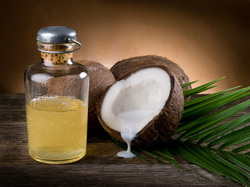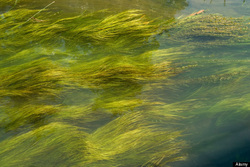
Coconut oil is affordable, readily available in most markets and is 100% non-toxic.
There are literally dozens of uses of coconut oil – and how you really should have it in your house for daily use in more ways than you can imagine! The best type of coconut oil to use is extra-virgin and organic.
Get the Skin You’ve Always Wanted…Naturally!
- 1. Reduce the appearance of age spots, wrinkles and varicose veins by rubbing coconut oil over your problem areas daily. It is similar in composition to the oils in your skin and stimulates new skin cell growth.
2. Say goodbye to razor burn and bumps! Using coconut oil before and after shaving will reduce irritation and redness but keep your pores clog-free!
3. Mixing coconut oil with equal parts sugar or fine sea salt makes an excellent all-over body scrub or facial exfoliator. Add essential oils such as peppermint or rose to personalize the scent.
4. Follow up with coconut oil immediately after your shower – then blot skin dry – for incredible softness from head to toe. Apply heavily to particularly dry areas such as feet and elbows.
5. Remove makeup by using a cotton ball dipped in coconut oil. Your face will feel fresh and clean without drying or irritating your skin.
6. Coconut oil is absorbed into the deepest layers of your skin without clogging your pores. It is the perfect moisturizer that heals damage and protects from the effects of psoriasis, eczema and acne.
7. Used as an eye cream, coconut oil helps reduce the appearance of bags and dark circles under the eyes. Apply gently around the eyes before sleeping.
8. Applying a layer of coconut oil to severely chapped lips will ease dryness and speed healing. Treat with coconut oil daily for supple lips and a natural SPF 4 protection!
9. Bug bites, new tattoos, sunburn and other skin surface injuries heal faster with coconut oil. Even bruises fade in less time! Coconut oil applied to damaged areas of your skin protects it from bacteria while stimulating new skin growth and faster healing. It smells wonderful and is safe for people of all ages and skin types.
10. If you tan, consider using coconut oil instead of over-the-counter tanning products. It will help retain your skin’s moisture and protect from damage. Sunshine is good for you and stimulates vitamin D production – but always spend time in the sun responsibly.
- 11. Rubbing coconut oil into your hair and scalp before shampooing will protect your hair from drying out from harsh detergents.
12. Use after you shampoo and condition as a leave-in conditioner. Apply a small amount to ends first, lightly distribute the rest throughout your hair then style as usual. Coconut oil helps control frizz, prevents split ends and keeps your hair silky and manageable.
13. If you have damaged, coarse, curly or hard to manage hair, deep condition by liberally applying coconut oil to your scalp and hair, cover with a shower cap and leave on overnight.
14. Coconut oil stimulates cell growth and if rubbed into bald areas of your scalp three times per day may help reverse hair loss.
15. If your family experiences a lice outbreak – so common with children in school, day care or summer camp – use natural treatments to remove them. Deeply saturate hair with coconut oil and cover with a plastic shower cap. Leave for at least one hour then rinse with apple-cider vinegar for a deeply cleansed and conditioned, lice-free head! Coconut oil is cheaper, safer, smells better and actually works – unlike those stinky chemicals sold at the store.
- 16. Though coconut oil is not compatible with latex, it is an excellent natural lubricant. Women who are menopausal or post-menopausal can use coconut oil to ease vaginal dryness without disturbing vaginal flora or feeling “greasy” – a common problem with over-the-counter lubricants. It also makes it excellent for massage oil.
17. If you are pregnant or recently gave birth, consider applying coconut oil to your belly every night to prevent and treat stretch marks. Coconut oil is more compatible with your skin than cocoa butter – the old standby since our grandmothers were having babies.
18. If you are breastfeeding, applying coconut oil in lieu of vitamin D ointment is more effective and safer for your nursing child. It likely tastes better to them as well! Also, consuming three tablespoons of coconut oil daily – such as in your coffee or smoothie – has been shown to enrich your baby’s milk supply.
- 19. If your baby is prone to diaper rash – or you apply rash cream regularly to prevent it – consider trying coconut oil instead. Baby skin is protected without chemicals of any kind.
20. Rub a bit of coconut oil into baby’s scalp to treat and prevent “cradle cap” which is a result of babies going from an all-water to an all-dry environment. Coconut oil is an excellent baby lotion free of any additives.
- 21. To “season” wood salad bowls, wood cutting boards and various cookware such as cast iron or pottery.
22. Make your own 100% non-toxic insect repellant by mixing coconut oil and peppermint oil extract. Apply to make yourself absolutely unattractive to insects of all varieties. This interesting use of coconut oil is cheaper, safer and smells far better than store-bought repellants.
23. Replace butter and all cooking oils with coconut oil in equal ratio – better for you when cooked at high heat and far more nutritious.
24. Coconut oil is safe for your pets. Add to your pets water daily or apply topically for fresh breath, sleek coat and prevention of joint disorders. Apply directly to irritated skin for natural relief. Pets that take coconut oil internally also have more energy. Talk to your vet about the right dose but a good rule of thumb is ¼ teaspoon for every ten pounds of pet weight.
25. Mix coconut oil with baking soda for whiter teeth, healthier gums and fresh breath. See our article about Oil Pulling with Coconut Oil for more oral health benefits!
There is no end to the uses of coconut oil we have yet to learn. Keep reading to find out how coconut oil can change your life and protect every cell in your body.
Read more about the general health benefits and uses of coconut oil. Discover startling information about coconut oil and Alzheimer’s disease today."

 RSS Feed
RSS Feed